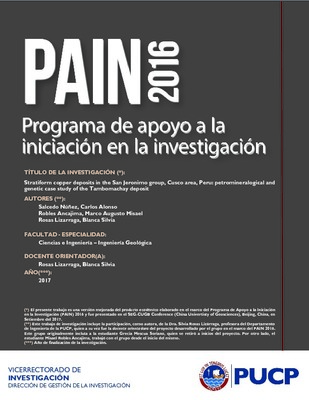Stratiform copper deposits in the San Jeronimo group, Cusco area, Peru: petromineralogical and genetic case study of the Tambomachay deposit

View/
Date
2017Author
Salcedo Núñez, Carlos Alonso
Robles Ancajima, Marco Augusto Misael
Rosas Lizarraga, Blanca Silvia
Metadata
Show full item recordAbstract
Near Cusco, in the southeast of Peru, copper oxide ores were extracted in nine small-scale historic mines. These deposits host stratiform copper orebodies within the Eocene-Oligocene San Jeronimo Group. One of these deposits, developed by the Tambomachay mine, was chosen for detailed study. The objective was to determine whether this could be classified as a SRHSCD. The methodology included bibliographic research, field work, and petromineralogical and geochemical analyses.
A feldspathic greywacke of the San Jeronimo Group, varying from 10 to 90 cm in thickness, hosts ore that is either disseminated predominantly along laminations or within veinlets. The primary minerals are chalcopyrite and bornite, there is also abundant chalcocite, and covellite-digenite replaces chalcocite. The presence of oxide minerals intergrown with the ores, particularly with covellite, chalcocite, and digenite, suggests a supergene enrichment event. Nevertheless, it is also possible that these oxides are of primary origin. The presence of calcite and chlorite has been observed in veinlets, with the chlorite suggesting some involvement of hydrothermal fluids. Geochemistry shows enrichment in metals that include Ag, Pb, and Zn, as well as in LILE elements. We preliminarily suggest that Tambomachay is a SRHSCD, based mainly on petromineralogical and geochemical analyses. The basin architecture of the studied area is similar to the general basin model that characterizes most SRHSCDs and this work conjectures that the source of the sulfur could be the evaporites of the Maras Formation. The textures, as well as the presence of chlorite and ore in veinlets, rule against a previously hypothesized syngenetic ore model. To confirm the existence of widespread SRHSCD occurrences, detailed geological and structural mapping, and fluid inclusion and isotope geochemistry will be carried out on the nine known occurrences in the Cusco region.
Temas
The following license files are associated with this item:

